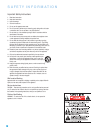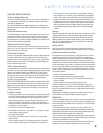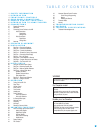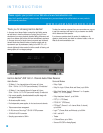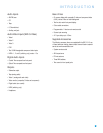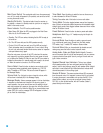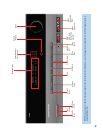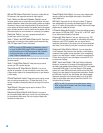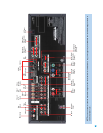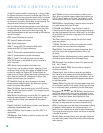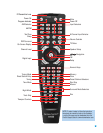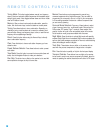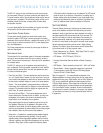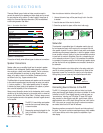
8
Main Power Switch: This mechanical switch turns the power supply
on or off. It is usually left pressed in (On position), and cannot be turned
on using the remote control.
Standby/On Switch: This electrical switch turns the receiver on
for playback, or leaves it in Standby mode for quick turn-on using this
switch or the remote control.
Power Indicator: This LED has four possible modes:
• Main Power Off: When the AVR is unplugged or the Main Power
Switch is off, this LED remains unlit.
• Standby: This LED turns amber, indicating that the AVR is ready to
be turned on.
• On: This LED turns white, and the AVR operates normally.
• Protect: If this LED ever turns red, turn off the AVR and unplug it.
Check all speaker wires for a possible short. If none is found, bring
the unit to an authorized Harman Kardon service center for inspection
and repair before using it again.
When the main power is turned off, the LED is dark and the receiver
won’t respond to any button presses. When the main power is turned
on, but before the Standby/On Switch is used, the LED turns amber to
indicate that the receiver is in standby mode and is ready to be turned
on. When the receiver is turned on, the LED turns white.
Source Select: Press this button to select a source device, which
is a component where a playback signal originates, e.g., DVD, CD,
cable TV, satellite or HDTV tuner. The source’s name will appear in
the Message Display.
Volume Knob: Turn this knob to raise or lower the volume, which
will be shown in decibels (dB) in the Message Display.
Message Display: Various messages appear in this two-line display
in response to commands and changes in the incoming signal. In
normal operation, the current source name and the analog or digital
audio input assigned to it appear on the upper line, while the surround
mode is displayed on the lower line. When the on-screen display menu
system (OSD) is in use, the message OSD ON will appear to remind
you to check the video display.
Tuner Band: Press this button to select the tuner as the source, or
to switch between the AM and FM bands.
Tuning: Press either side of this button to tune a radio station.
Tuning Mode: This button toggles between manual (one frequency
step at a time) and automatic (seeks frequencies with acceptable signal
strength) tuning mode. It also toggles between stereo and mono modes
when an FM station is tuned.
Preset Stations: Press this button to select a preset radio station.
Headphone Jack: Plug a 1/4" headphone plug into this jack for
private listening.
Surround Mode: Press this button to select a surround sound
(e.g., multichannel) mode group. Choose from the Dolby modes,
DTS modes, Logic 7 modes, DSP modes or Stereo modes.
Surround Select: After you have selected the desired surround
mode group, press this button to select a specific mode.
Analog Audio, Video and Digital Audio Inputs: Connect a
source component that will only be used temporarily, such as a camera
or game console to these jacks. Use only one type of audio and one
type of video connection.
Speaker/Channel Input Indicators: The box icons indicate
which speaker positions you have configured (see the Initial Setup
section), and the size (frequency range) of each speaker. When a digital
audio input is used, letters will light inside the boxes to indicate which
channels are present in the incoming signal.
Remote IR Sensor: This sensor receives infrared (IR) commands
from the remote control. It is important to ensure that it is not blocked.
If covering the sensor is unavoidable, such as when the AVR 154 is
placed inside a cabinet, you may use an optional Harman Kardon
HE 1000, or other infrared receiver, with an IR emitter (“blaster”)
placed directly over this sensor.
FRONT-PANEL CONTROLS




